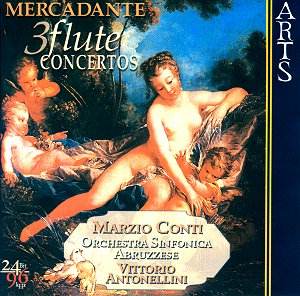Let's get the inessentials
out of the way first. The performers'
use of the "new critical edition - edited
by 'Boccaccini e Spada editore'" is
hardly a drawing card, save perhaps
for a handful of musicologists. We simply
don't hear this music frequently enough
to be aware of such niceties. Then,
Danilo Prefumo, in the booklet, makes
much of the use of the large-orchestra
scoring of the E minor concerto - there
exist also a flute-and-strings edition
and a flute-quartet chamber version.
The climactic tuttis certainly
make a grand sound; but both here and
in the E major concerto, scored for
a similarly proportioned ensemble, the
strings continue to carry the bulk of
the musical freight, as they would in
a smaller orchestra, with the winds
relegated to a supporting role.
So why should you hear
this record? Well, the music is beautiful,
which is probably the best reason. We
know Mercadante in the opera house as
a budding bel canto composer.
His cantilenas are perhaps less appealing
and pliant than, say, Bellini's, but
lovely, while the virile, martial cut
of his ensembles foreshadows early Verdi.
Both styles are amply present in these
concerti, which infuse rigorous Classical
structures with the expanded expressive
range of the dawning Romantic period.
The poised, deceptively artless cantilenas
of the central slow movements explore
layers of ambiguous emotion. Conversely,
the final Rondo russo of Op.
57, with its strongly-marked gypsy rhythms,
and the bouncy Polacca finales
of the other two scores, are all pleasingly
infectious.
Marzio Conti is also
worth getting to know. The stereotypical
flute sound, all too familiar even in
some professional orchestras, is breathy,
chiffy, and occasionally sharp in pitch.
Avoiding this, more accomplished players,
including both Rampal and Galway among
famous virtuosi, cultivate a big, round,
somewhat hard-edged timbre. Conti's
playing avoids both these extremes,
offering a distinctive lean, clear sonority,
projecting the composer's embellished
solo lines with shapely phrasing and
a liquid, well-bound legato. In the
highest reaches, he doesn't always maintain
the legato air stream impeccably (track
2, 1:27), but the tone stays clear and
the intonation accurate - the peak of
the arpeggio at track 7, 6:58, is "placed"
dead in tune. The color change in the
descending arpeggios of the E major
concerto suggests a singer's register
break - an odd effect on the flute,
but not an inappropriate one in this
operatically conceived style. Only in
the D major concerto does Conti's technique
falter briefly: the opening broken octaves
are careful, and his phrasing is labored
in some of the passagework. Otherwise,
it's a pleasure to hear such accomplished,
individual playing. Presumably his intention
in choosing this program was to avoid
the overworked Mozart concerti, but
now I'd like to hear him play them.
The Orchestra Sinfonica
Abruzzese respond plausibly to Vittorio
Antonellini's leadership, but sustained
supporting winds occasionally obscure
the faster-moving violin themes in the
ritornellos of the D major concerto.
The booklet suggests "utilizing a DVD
sound carrier and player" for best effect,
though the disc isn't explicitly labeled
as DVD Audio - just 24-bit/96 kHz "standard"
digital. Standard CD playback balances
the soloist well against the rather
bright-toned orchestra, with ample depth,
but some glare in full wind chords as
well. The label offers the total program
timing as 56.15, but my CD readout indicates
it as in the headnote.
Stephen Francis Vasta


